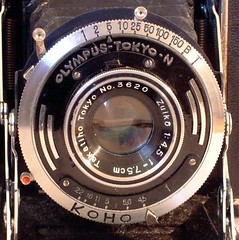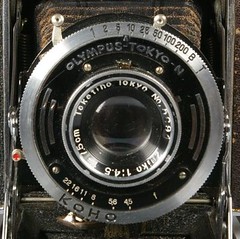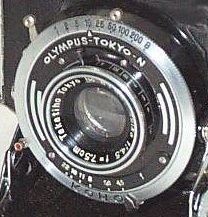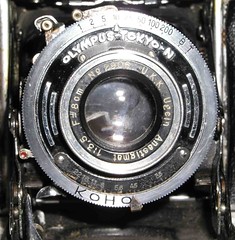Koho
The Koho (Kōhō) is a leaf shutter, made from 1937 by Takachiho (predecessor of Olympus). It was inspired by the German Prontor.[1] All the versions are in #0 size and have a self-timer. The Koho was mainly mounted on the Semi Olympus, Semi Olympus II and Olympus Six, but Takachiho also sold it to other makers.
Contents
Laurel predecessor
The first shutter made by Takachiho was called Laurel (ローレル, rōreru), it is the direct predecessor of the Koho. The Laurel has 1, 2, 5, 10, 25, 50, 100, 150, B, T speeds. The early version of the Semi Olympus II, with off-center finder, was advertised in late 1937 with a Laurel shutter.[2] The name "Laurel" was dropped because it was already registered,[3] and the picture of a Semi Olympus II appears in an advertisement dated May 1938 with the transitional name DAURED on the shutter rim, certainly the result of a retouch.[4]
Versions of the Koho
  
|
| Left: Koho, first version to 1/150 image by Adrian Gotts (Image rights) Middle: Koho, second version to 1/200 image by Henk (Image rights) Right: Koho, third version to 1/200 image by M. Walters (Image rights) |

|
| Second version to 1/200, unusual variant with no T setting image by Richard Marks (Image rights) |
The first version of the Koho is similar to the Laurel, with the same speed range: 1, 2, 5, 10, 25, 50, 100, 150, B, T. As seen from the front, it has the winding lever at the top right, the release lever at the top left, the self-timer lever at the bottom left (with a red dot), and a thread on the left for a cable release. There is a serial number engraved on the side of the casing — numbers are confirmed in the 13xxx and 14xxx range, in a sequence that certainly started at 10000 or 10001. The first version was mounted on the Semi Olympus II, and at least one example is known on a Semi Olympus.[5]
The second version has the same controls and a top speed of 1/200. It has been observed on late examples of the Semi Olympus II and on at least one example of the Semi Olympus (I).[6] This version has a serial number too, on the same location — known numbers are in the 15xxx range.
The third version has the same speed range (1, 2, 5, 10, 25, 50, 100, 200, B, T) but it is adapted for a body release. It has the winding lever at the top left, the self-timer lever with a red dot at the bottom left, and the release also at the bottom left, activated by the cam of the body release. The aperture setting has moved to the top of the shutter housing. No cable release attachment is provided, and no serial number is visible. This version was mounted on most variants of the Olympus Six. In some advertisements for the Olympus Six the shutter was sometimes called Koho II, Koho III or New Koho III.[7]
Other cameras equipped with a Koho shutter

|

| |
| Second version on a Ugein, with additional body release linkage image by Stephan Van den Zegel (Image rights) |
Third version on a Zeitax image by Dan Orton (Image rights) |
The Koho shutter was supplied to various camera makers and distributors, in all three versions. Some cameras equipped with a body release have the first or second version of the Koho, with a linkage added behind the shutter casing to connect the top-mounted release lever to the body release mechanism.
On all the Koho shutters supplied to other manufacturers, the front plate is the same as on the Semi Olympus II, inscribed Olympus-Tokyo-N at the top. This plate has room at the bottom for an aperture scale; this room is left blank on the cameras which have the aperture scale above the shutter housing.
List of equipped cameras:[8]
- V Semi First (first version observed)
- Kelly (reportedly advertised with 1–150 speeds, first and third versions observed)
- Semi Proud (reportedly announced at the time, first version observed with body release linkage)
- Sintax (second version observed, with body release linkage; third version advertised with the word SINTAX added at the bottom of the shutter plate)
- Semi Rody (unknown version advertised)
- New Semi Condor (second version observed, with body release linkage)
- Zeitax (third version observed)
- National and Ugein (first version advertised; second version observed, with body release linkage)
- Mamiya Six III (third version observed)[9]
The Kōhō name
The name Kōhō was written コーホー in katakana, but it certainly comes from the word 高峰, which means "high peak" or "high mountain".[10] This is a clear allusion to the Olympus name (itself from Mount Olympus).
Notes
- ↑ Sakurai Eiichi, p.65 of Kurashikku Kamera Senka no.20.
- ↑ Advertisement in Asahi Camera October 1937, reproduced in Kokusan kamera no rekishi, p.62, and in Hibi, p.62 of Kurashikku Kamera Senka no.8; brochure available in pdf format in this page of the Zuiko Club website.
- ↑ Francesch, p.24. Hibi, p.63 of Kurashikku Kamera Senka no.8, says that it was registered by Tōkyō Kōgaku but this is perhaps a confusion with the postwar Laurelflex made by that company.
- ↑ Advertisement reproduced in Hibi, p.62 of Kurashikku Kamera Senka no.8.
- ↑ See Semi Olympus (I).
- ↑ See Semi Olympus and Semi Olympus II.
- ↑ For example in an Olympus Six brochure available in this page of the Olympus corporate site.
- ↑ See the corresponding camera pages for the sources.
- ↑ Example pictured in McKeown, p.644.
- ↑ See this page of the Olympus corporate site, and Francesch, p.24.
Bibliography
- Asahi Camera (アサヒカメラ) editorial staff. Shōwa 10–40nen kōkoku ni miru kokusan kamera no rekishi (昭和10–40年広告にみる国産カメラの歴史, Japanese camera history as seen in advertisements, 1935–1965). Tokyo: Asahi Shinbunsha, 1994. ISBN 4-02-330312-7.
- Baird, John R. Collectors guide to Kuribayashi-Petri Cameras. Grantsburg, WI (USA): Centennial Photo Service, 1991. ISBN 0-931838-16-9. P.75.
- Francesch, Dominique and Jean-Paul. Histoire de l'appareil photographique Olympus de 1936 à 1983. Paris: Dessain et Tolra, 1985. ISBN 2-249-27679-X.
- Hibi Takashi (日比孝). "Nihon no supuringu kamera: Orinpasu" (日本のスプリングカメラ・オリンパス, "Japanese folding cameras: Olympus"). Kamera Rebyū: Kurashikku Kamera Senka (カメラレビュー クラシックカメラ専科) / Camera Review: All about Historical Cameras no.8, September 1986. No ISBN number. Supuringu kamera (スプリングカメラ, special issue on spring cameras). Pp.62–5.
- Maitani Yoshihisa (米谷美久). "Kamera-zukuri e no bōken" (カメラ創りへの冒険, "Venturing into camera production"). Volume 1 of Haikei — Sekkeisha yori (拝啓・設計者より, "Dear Sir, from the designer"). Published in the Zuiko Club website, belonging to the Olympus Imaging Corp.
- McKeown, James M. and Joan C. McKeown's Price Guide to Antique and Classic Cameras, 12th Edition, 2005-2006. USA, Centennial Photo Service, 2004. ISBN 0-931838-40-1 (hardcover). ISBN 0-931838-41-X (softcover).
- Orinpasu-ten — oputo-dejitaru-tekunolojī no kiseki (オリンパス展・オプトデジタルテクノロジーの軌跡, Olympus exhibition, the tracks of opto-digital technology). Tokyo: JCII Camera Museum, 2005. (Exhibition catalogue, no ISBN number.)
Links
In Japanese: